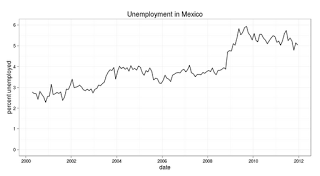There are three main parties in Mexico:
- The Partido Revolucionary Institucional (PRI) commonly described as center-left. Its candidate is the former governor of the State of Mexico Enrique Peña Nieto (EPN)
- The Partido Acción Nacional (PAN): The right-wing party which currently holds the presidency. Its candidate is Josefina Vázquez Mota (JVM)
- The Partido de la Revolución Democrática: A left wing party which lost the presidency in 2006 by the razor thin margin of .56%. It’s candidate is the same one as in 2006, Andrés Manuel López Obrador (AMLO)
The Data
My data comes from the poll of polls by ADN Político. I made some adjustments to the data:
- I’m using the midpoint of the start and end dates of the surveys as the polling date
- I added a couple of polls conducted by Indemerc and corrected some missing polls from El Universal - Buendía y Laredo
- I’m using weekly averages of the GEA-ISA daily tracking poll because it has some weird periodical artifacts
The Model
My first idea was to simply model the presidential race using a dirichlet regression for all four candidates smoothed with splines. This ignores any effect each polling firm may have (some polling firms tend to favor one particular candidate)
I later switched to a Bayesian method of pooling the polls. I’m using a Kalman Filter that corrects for House Effects (the bias of each polling firm) as described in Pooling the Polls Over an Election Campaign (pdf), by Simon Jackman (any mistakes are obviously mine). The only difference from the paper (a minor one) is that since Australia has two main political parties and Mexico has 3 main ones plus one small one, the precision is calculated a bit differently.
I could certainly have improved the forecast by taking into account the economic and security conditions in Mexico since those are the two issues which come out on top when voters are asked what they care about the most. But with virtually only one free presidential election having happened in Mexico (the 2006 one doesn’t count since it was very close) it would involve more time than I’m willing to commit.
 |
Forecast
Mexico enforces a polling ban three days before the election (starting tomorrow) and there seems to be very noticeable trend in the voting intention of the candidates so I simulated draws from the posterior voting intention of each candidate and then used the auto.arima function from the forecast package to predict what the trend would be on election day.
House Effects
The model could also be improved by using better priors for the house effect of each polling firm. For example, if you believe there is an institutional bias in favor of Peña Nieto and that the most thrustworthy pollster are Reforma, SDP Noticias and UNO TV then you’ll disagree with the estimate from the model I’m using with diffuse priors.
The three polling firms where Peña Nieto polled the worst where Grupo Reforma, SDP Noticas-Covarrubias, and UNO TV-María de las Heras (María de las Heras was the worst pollster at predicting the 2006 election). All three polling firms reported and increase in Peña Nieto voting intention from May to June (Uno TV 39% -> 40.1%, SDP Noticias 40% -> 41%, and Reforma 38% -> 42%)
It would take an act of god for Peña Nieto not to be declared the winner on Sunday. The probability of AMLO beating JVM for the second place is 96%.
I may still be missing one or two polls in this analysis so be sure to visit my interactive chart for the latest info and forecast.
One thing is for certain: there is no stopping Enrique Peña Nieto; the PRI will soon be here. And I for one welcome our new prehistoric overlords. I’d like to remind them that as a trusted blog personality, I can be helpful in hiding crime statistics (under the bed) while the proletariat toils in their underground meth labs.
References
Pooling the Polls Over an Election Campaign, Australian Journal of Political Science, 2005 V40(4):499-517






